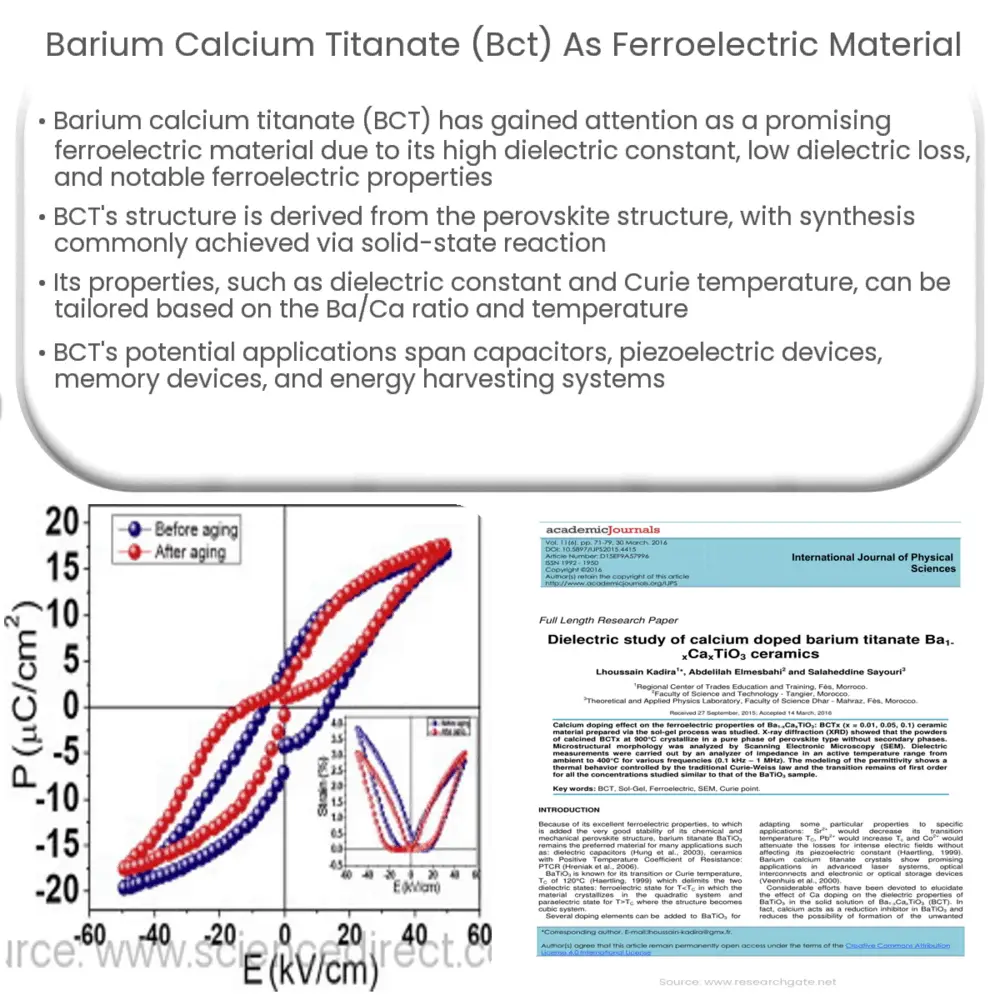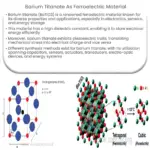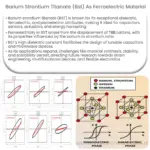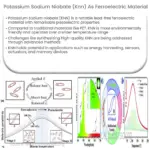Barium calcium titanate (BCT) is a ferroelectric material with high dielectric constant, low loss, and excellent piezoelectric properties, used in capacitors, sensors, actuators, and memory devices.

Barium Calcium Titanate (BCT) as Ferroelectric Material
Introduction
Barium calcium titanate (BCT), a solid solution of barium titanate (BaTiO3) and calcium titanate (CaTiO3), has gained considerable attention in recent years as a promising ferroelectric material. This compound exhibits a variety of remarkable properties, such as high dielectric constant, low dielectric loss, and excellent ferroelectric behavior, which make it suitable for a wide range of applications, including capacitors, transducers, actuators, and memory devices. In this article, we will explore the structure, synthesis, and properties of BCT, as well as its potential applications in various fields.
Structure and Synthesis of BCT
The crystal structure of BCT is derived from the perovskite structure (ABO3), where A and B are two different cations and O represents the oxygen anion. In the case of BCT, the A site is occupied by a mixture of barium (Ba) and calcium (Ca) ions, while the B site is occupied by titanium (Ti) ions. This structure results in a complex interplay of ionic displacements and rotations, leading to the ferroelectric behavior observed in BCT.
Several synthesis methods can be employed to produce BCT, such as solid-state reaction, sol-gel, hydrothermal, and molten salt synthesis. Among these, the solid-state reaction method is the most commonly used due to its simplicity and cost-effectiveness. In this process, stoichiometric amounts of BaCO3, CaCO3, and TiO2 are mixed and heated at high temperatures (typically between 1200-1350°C) to form the BCT compound. However, other synthesis methods, such as the sol-gel process, can offer advantages in terms of particle size control, homogeneity, and purity of the final product.
Properties of BCT
The ferroelectric properties of BCT are highly dependent on the Ba/Ca ratio and the temperature. At room temperature, BCT exhibits a tetragonal perovskite structure, which is responsible for its ferroelectric behavior. As the temperature increases, a series of phase transitions occur, leading to changes in the crystal structure and dielectric properties. The Curie temperature (Tc), which corresponds to the transition from the ferroelectric to the paraelectric phase, varies with the Ba/Ca ratio and can be tailored to suit specific applications.
BCT has a high dielectric constant, which can be several orders of magnitude greater than that of conventional dielectric materials, such as silicon dioxide or aluminum oxide. This property is particularly beneficial for capacitive applications, where high dielectric constants enable increased energy storage and miniaturization. Furthermore, BCT exhibits low dielectric loss, which is crucial for minimizing energy dissipation in electronic devices.
Another essential characteristic of BCT is its excellent piezoelectric and electrostrictive properties, which arise from the coupling between the electric field and the mechanical strain in the material. These properties allow BCT to convert electrical energy into mechanical motion (or vice versa), making it suitable for use in sensors, actuators, and energy harvesting devices.
Applications of BCT
Given its unique combination of properties, BCT has been investigated for a variety of applications, some of which are discussed below:
1. Capacitors
Due to its high dielectric constant and low dielectric loss, BCT has emerged as a promising material for the fabrication of high-performance capacitors. These capacitors can store more energy per unit volume compared to conventional dielectric materials, enabling the miniaturization of electronic devices and power systems. Additionally, BCT-based capacitors can exhibit excellent temperature stability, which is crucial for maintaining consistent performance across a wide range of operating temperatures.
2. Piezoelectric and Electrostrictive Devices
Thanks to its strong piezoelectric and electrostrictive properties, BCT has found applications in various transducers, actuators, and sensors. For instance, BCT-based piezoelectric devices can be used in ultrasonic imaging, pressure sensors, and vibration control systems. On the other hand, electrostrictive actuators made from BCT can deliver precise and rapid motion, making them suitable for applications such as adaptive optics, micro-electromechanical systems (MEMS), and microfluidics.
3. Ferroelectric Memory Devices
BCT’s ferroelectric properties have spurred interest in its use as a non-volatile memory material. In ferroelectric random access memory (FeRAM) devices, BCT’s spontaneous polarization can be used to store binary information by applying an external electric field. Compared to conventional memory technologies, FeRAM offers advantages such as low power consumption, fast switching speeds, and excellent endurance. Moreover, the scalability of BCT-based FeRAM can contribute to the ongoing miniaturization of memory devices.
4. Energy Harvesting
BCT’s piezoelectric properties also make it an attractive material for energy harvesting applications. By converting mechanical vibrations, such as those generated by human movement or ambient sources, into electrical energy, BCT-based energy harvesters can provide a sustainable power source for low-power electronic devices, such as wearable gadgets, wireless sensors, and biomedical implants.
Conclusion
Barium calcium titanate (BCT) has emerged as a promising ferroelectric material due to its unique combination of high dielectric constant, low dielectric loss, and excellent piezoelectric and electrostrictive properties. The diverse range of potential applications for BCT, including capacitors, transducers, actuators, memory devices, and energy harvesting systems, highlights its potential to revolutionize various fields, from electronics to energy management. Ongoing research efforts are aimed at further understanding and optimizing the properties of BCT to enable the development of more efficient and sustainable devices and systems.




